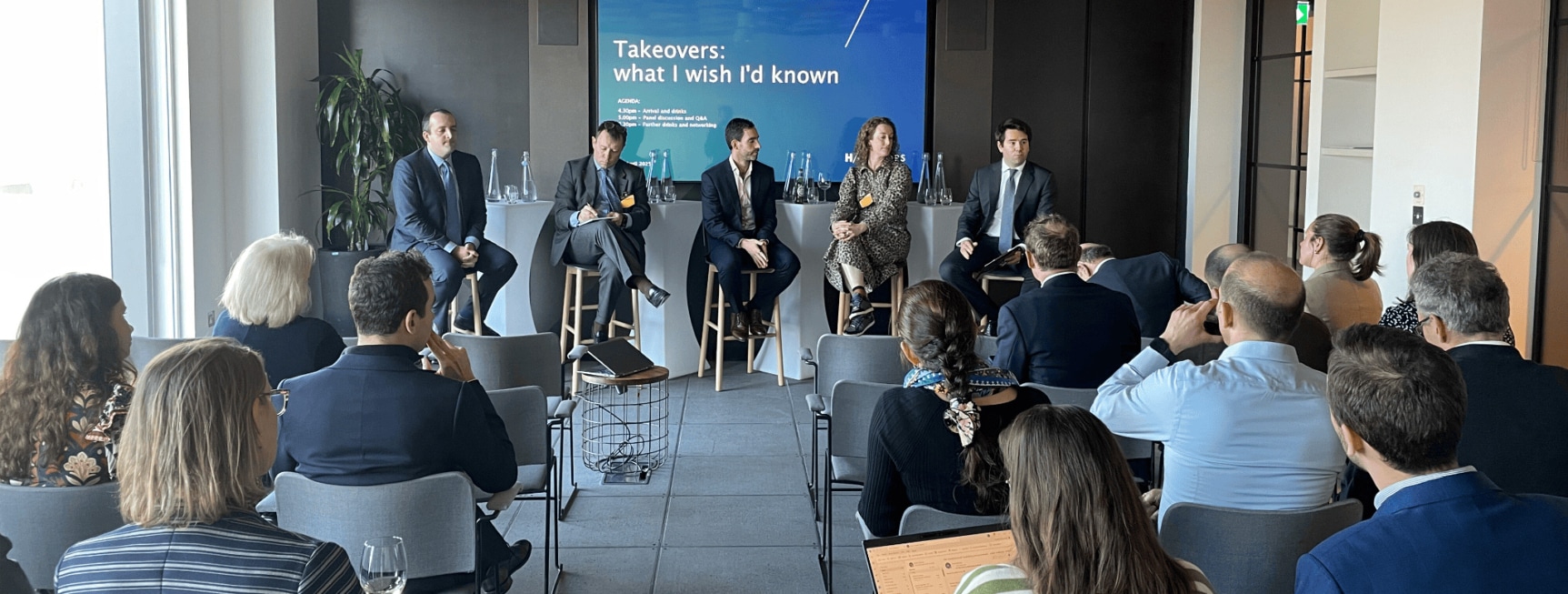Last year, nearly 100 companies were delisted from the London Stock Exchange, the majority due to takeover bids. In such scenarios, Investor Relations (IR) and communications professionals play a pivotal role in preparing for, responding to, or executing public takeover offers and bids. Yet, many in these roles may never have navigated a transaction before. To shed light on this, H/Advisors Maitland hosted a panel of experts who discussed how IR and communications leads can add value during merger and acquisition (M&A) processes.
Cohesion is King
A strong, united team—comprising advisors, brokers, lawyers, and senior leadership—is critical to the success of any M&A process. When the key players have established working relationships, the process becomes more manageable: decision-making flows more smoothly, and the overall workflow is more efficient. Establishing a strong team foundation early on can significantly influence the outcome of a deal.
Advisors who are familiar with each other’s working styles can provide consistency and reduce risks, improving the chances of a successful transaction. These deals can prove to be lengthy, gruelling processes so cohesion, camaraderie and collaboration can make a world of difference.
When the IR role shifts
During an M&A process, the role of an IR professional undergoes a dramatic shift. Traditionally, IR professionals are responsible for conveying strategic direction whilst navigating and nurturing shareholder relationships.
However, once a deal is in progress, brokers and lawyers take the reins. This shift can be a challenge for IR teams, as their typical responsibilities are essentially put on pause. The key is to find new ways to add value during this period, whilst leaning on trusted advisors.
Prepare, prepare, prepare
M&A processes are complex, highly regulated, and involve numerous stakeholders, so it’s vital that leaders are thoroughly prepared.
Never underestimate the complexities of an M&A transaction. Preparedness is key to overcoming challenges. This includes conducting thorough “war games” and developing a written, comprehensive plan. Simulations and scenario planning help teams prepare for every possible eventuality, which ultimately leads to a smoother and more coordinated response when faced with unexpected hurdles.
Muscle memory for such intricate processes is nearly impossible and therefore having something pre-agreed written on paper is a helpful way to ensure alignment.
Our panellists shared insightful examples from their experience, underpinning the need for robust preparation. Whether it’s a company that boasts 25 years of being public riding the high of reaching the FTSE 100, or one facing sector headwinds in the fourth year of listing, companies can be at risk of takeover. The unpredictability cannot be overstated, so preparation and robust, aligned teams are imperative, regardless of company size or age.
Don’t underestimate the challenge
“A deal is a living breathing thing, that doesn’t sleep once it closes or is announced”.
IRs are often the spokesperson for a heavily regulated moving picture, with multitudes of stakeholders with different priorities and different needs in terms of information sharing.
Internal audiences are a crucial part of this stakeholder mapping process and are naturally predisposed against the uncertainty these transactions inevitably cause. Ensuring employees trust the process and understand why confidentiality must be upheld. Transparency, to the extent that it’s possible, helps employees feel connected to the bigger picture, maintaining their trust and morale.
As with almost every other part of this process, the transaction timeline is too late to start – trusted relationships and communication strategies should be embedded into the business well in advance. This, in turn, protects talent retention and ultimately customer satisfaction and business performance.
Controlling the narrative
For the acquirer, crafting a compelling and strategic narrative around the merger can be a crucial element of ensuring success. A well-structured story that clearly articulates the strategic benefits and long-term vision of the merger helps rally support from stakeholders and employees. Moreover, it can sway regulators and other key players in favour of the deal.
Effective communication and media strategy are paramount. Building strong relationships with journalists and maintaining control over the narrative flow can prevent unwanted leaks and ensure your strategic messaging is embedded throughout the reporting.
M&A journalists, eager for the scoop, often prioritise speed over accuracy, so timing and cultivating trusted media relationships are essential in delivering your strategic messages.
Even after a leak, the right communications team can help mitigate the damage. With established media relationships, advisors can quickly correct inaccuracies and ensure that the most important details are shared with the public.
The leak trap
However, in the pursuit of controlling the narrative, companies may be tempted to leak information to the media, often with the intention of influencing outcomes or negotiation perimeters. Around 25% of M&A deals suffer leaks, often strategically timed to force parties to the table or to pressure test valuations.
More often than not, these leaks backfire – jeopardising the entire deal. In fact, leaks can occur up to 50 days before a deal announcement and therefore instead of ensuring narrative control, it often starts the clock prematurely, leaving parties scrambling.
Eyes on 2025
In 2024, 60% of offers for UK public limited companies came from international buyers, with half of those bids originating from the U.S. This global interest in UK companies underscores the importance of being prepared for international deals.
The UK’s fundamentals remain strong, supported by a stable government and an appetite for investment from global markets.
However, our event took place on the evening of Trump’s ‘Liberation Day’, serving as a reminder that geopolitical uncertainty casts a long shadow, resulting in an environment where rational financial analysis, and action, is challenging.
Written by: Katie Hughes, Senior Consultant.









